Friends in the crypto community, the market in the past few days has been like a roller coaster 🎢, with big news and small explosions coming one after another, truly overwhelming!
Today, let’s discuss the hot topics hitting the screens: the $4.5 million CrediX incident, the amazing phenomenon of NFT user activity surpassing DeFi, the bullish target of Binance Coin (BNB) pointing to $1,000, and the duel between Ethereum and Cardano, not to mention the overall crypto market value surging by $200 billion!
Be prepared; the feeling of illustrated texts relies on imagination, while valuable insights rely on facts—grab your coffee or simply enjoy watching cats as you read on.😼☕️
1) CrediX: From 'patching vulnerabilities' to 'vanishing into thin air' in 72 hours
On August 4, a DeFi project named CrediX was attacked, losing about $4.5 million from its liquidity pool. After the incident, the project team verbally promised compensation or repairs within 24–48 hours, but the promise was not fulfilled: the official website and social media went offline, and the team went dark.
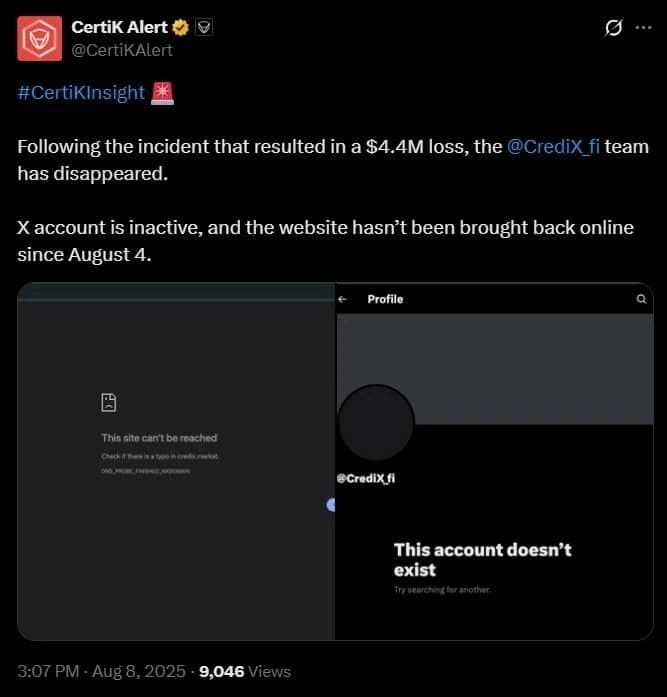
Many people refer to this situation as a 'rug pull'—although there is currently no conclusive evidence that this was a premeditated exit scam, the disappearance itself has left users in panic.
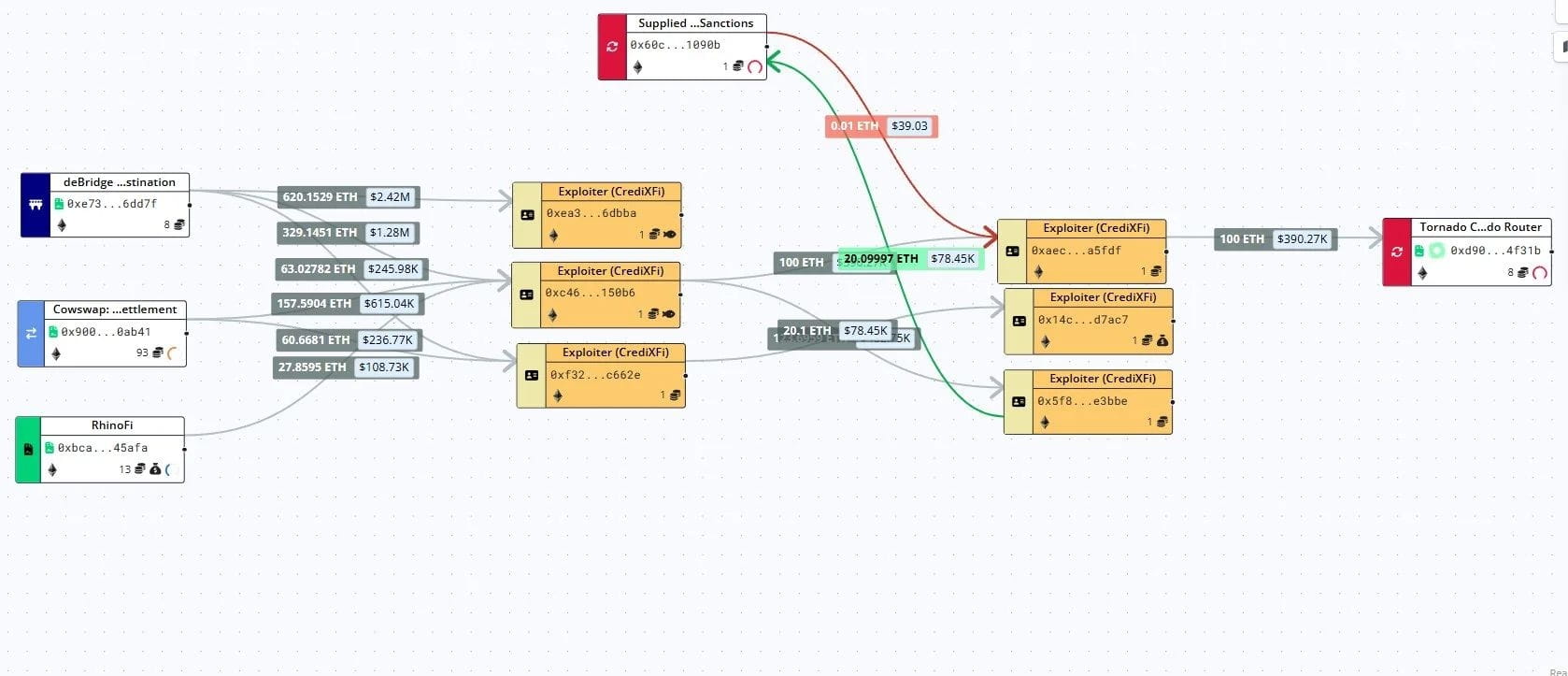
On-chain traces indicate that about $400,000 was transferred through mixing services (like Tornado Cash), with the remaining funds staying inactive in several private wallets.
What’s more troublesome is that some non-custodial platforms are quietly listing CrediX’s pool tokens in trading pairs—this is akin to planting a time bomb for unsuspecting traders, potentially triggering further liquidations and losses.
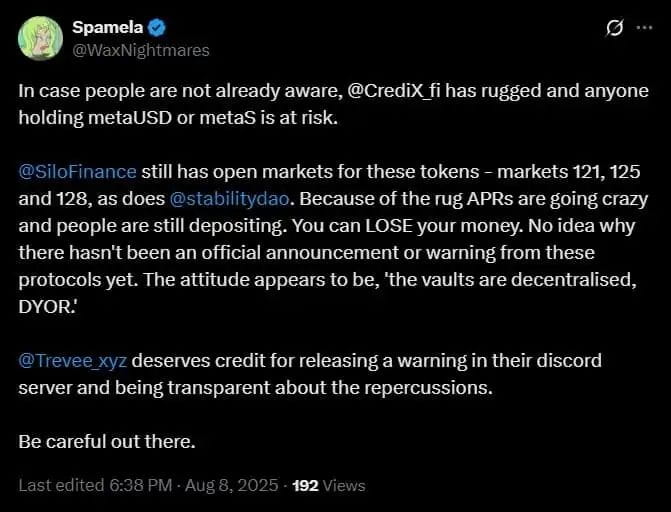
Short comment: Such events remind us—decentralization does not equal risk-free; the transparency of a project and its emergency response speed will determine the extent of losses at critical moments.
2) Macro comparison: DeFi has not declined; it has just changed its form (TVL hits new highs)
If we consider the CrediX case as a 'localized collapse', the broader picture shows that DeFi as a whole still has strong vitality: In July, DeFi's liquidity (Total Value Locked, TVL) hit a record high of $270 billion, representing a month-over-month growth of about 30%. This indicates that capital has not completely left on-chain finance—it is simply leaning more towards large mature protocols, cross-chain bridges, and high-frequency liquidity markets.
In other words—risks are concentrated locally, but capital is still seeking returns and efficiency on a broader scale. Projects like CrediX, which are 'small and fragile', are more likely to be scrutinized amid severe fluctuations.
3) NFTs: The drama is returning, and user activity has quietly surpassed DeFi.
The most interesting contrast is: although the total trading volume of NFTs still lags significantly behind the peak of 2021, in terms of 'user engagement', NFTs are already ahead. Data from DappRadar indicates:

🎨 The daily active wallets of NFT DApps are about 3.85 million, slightly higher than DeFi.
🎨 In July, NFT trading volume surged by 96%, reaching $530 million, with the average transaction price doubling to $105.
🎨 In the Ethereum ecosystem, Blur accounts for ~80% of daily NFT trading volume, OpenSea still leads with 27,000 active traders, and Zora stands out for its low-cost minting tools.
🎨 Luxury brands (Louis Vuitton, Rolex) and Nike, Coca-Cola, etc., are also advancing NFT-related pilot projects, with traditional collectibles (like CryptoPunks) occupying nine out of the ten highest transaction volumes in the past day, showing a resurgence of 'blue-chip NFTs'.
But don’t forget the reality: even with a rebound in July, the total NFT trading volume for the entire year of 2024 is still down 19% year-on-year, with sales declining by 18%. The total sales in the first half of 2025 amount to $2.82 billion—still a considerable gap from the 'hundreds of billions in monthly trades' seen in 2021. In other words, the recovery is real, but both the scale and quality are being reshaped.
4) BTC, ETH, and altcoins: Market capitalization, dominance, and rotation games
In the past few days, market sentiment has turned optimistic: the total market capitalization of crypto assets increased by about $200 billion in just a few days, once again surpassing $4 trillion.
BTC encountered resistance around $117,000 after a surge, stabilizing its market capitalization at around $2.33 trillion, but its market dominance has fallen to 58%, indicating that capital is rapidly shifting towards altcoins and Ethereum—this is typically a hallmark of 'altcoin season' or rotational markets.
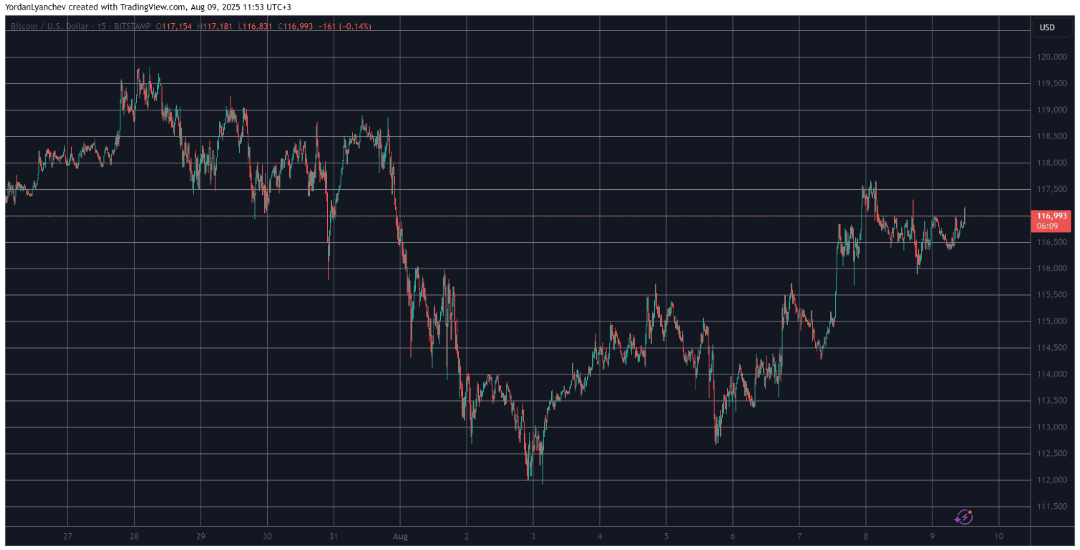
ETH performed impressively: once breaking through $4,200, reaching a three-and-a-half-year high, it spurred on-chain trading and NFT activity. Meanwhile, most altcoins (such as DOGE, LINK, HYPE) and mid-cap coins (like CRO, UNI, XMR, etc.) have also shown strong performance in the short term, with ENA, PEPE, etc., experiencing double-digit increases. The Pi Network token was also mentioned (short-term rebound to $0.4, users should carefully assess token compliance and liquidity).
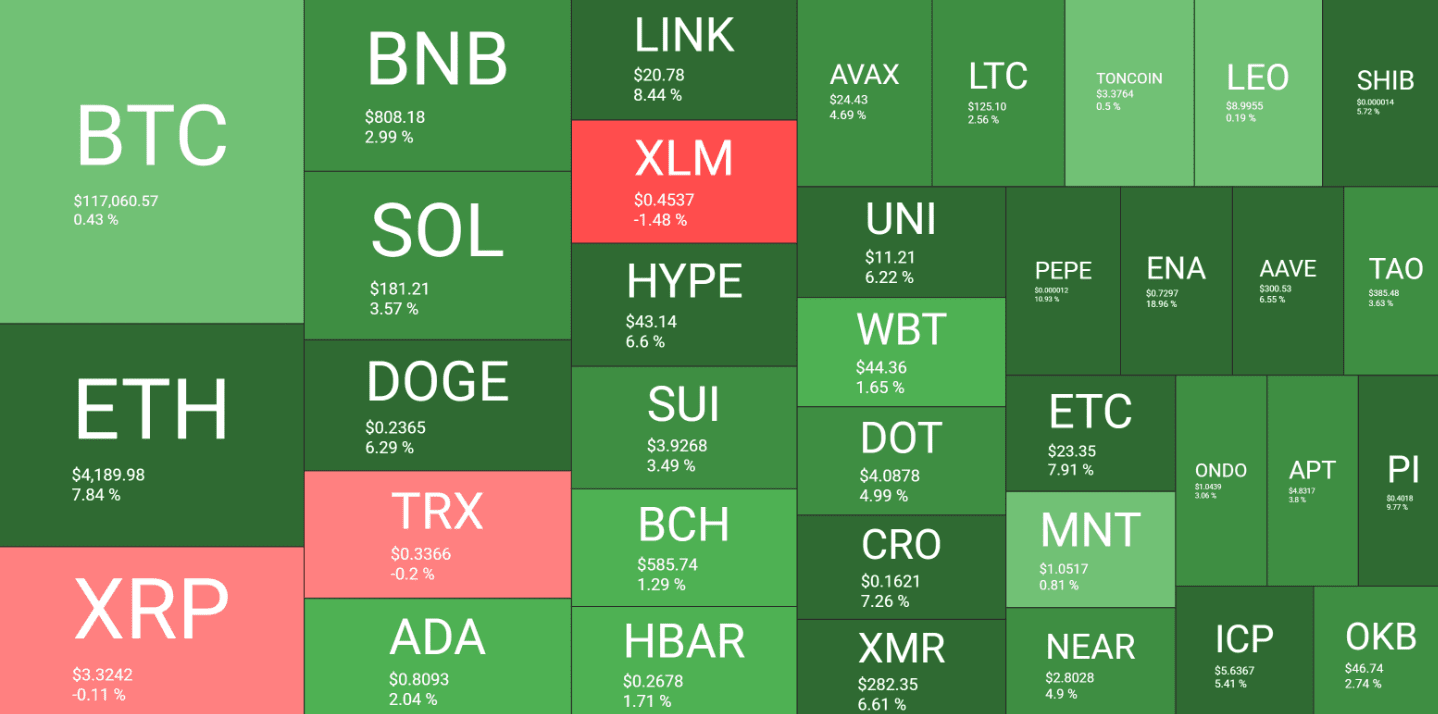
Intuitive conclusion: Bitcoin's 'money-sucking' advantage is diminishing, and the market is presenting more speculative opportunities of the 'risk appetite + high leverage' type, favoring projects and tokens that can attract attention and traffic in the short term.
Although the market fluctuates constantly, ETH remains the safest haven in the eyes of investors due to its large developer community, rich decentralized application (DApp) ecosystem, and strong network effects.
But don’t forget, a 'potential stock' is quietly rising—Cardano (ADA). Built by Ethereum co-founder Charles Hoskinson, Cardano employs a unique peer-review mechanism and proof-of-stake (PoS) consensus, focusing on security and scalability. Recently, with the gradual improvement of its DeFi capabilities, the infrastructure and community support for ADA have been rapidly strengthening.
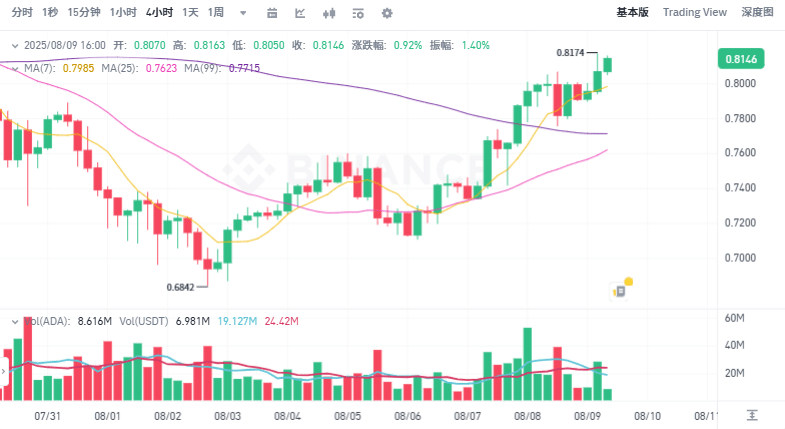
Many analysts believe that as the market enters the 'altcoin season', Cardano is poised to be a strong competitor. It is not only technologically advanced but also possesses strong sustainability, which may challenge Ethereum's dominance in the smart contract domain in the future.
5) The narrative of BNB: supply contraction + chain performance = the supporting role or leading role in the bull market story?
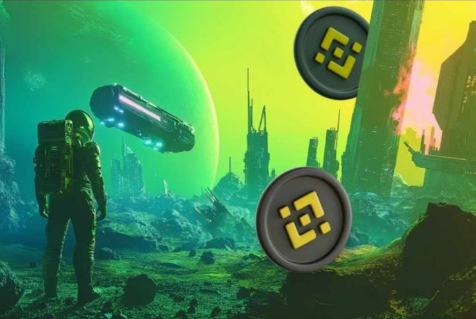
BNB has also recently been under scrutiny: currently, the price of BNB hovers around $809, with both technical aspects and token economics providing optimistic arguments.
Recently, Binance conducted its 32nd quarterly burn, destroying a total of 1.59 million BNB, and the ongoing burn mechanism means that the long-term circulating supply is marginally compressed.
BNB chain claims to have reached a processing speed of 20,000 transactions per second; if this can be stabilized and widely adopted by developers, it will support on-chain activities and the demand side for BNB.
Overall ecological development is strong. Binance, as one of the largest exchanges globally, continues to see increasing applications and capital flow on its chain, forming a virtuous cycle.
Technical indicators (like Bollinger Bands) and volume after breakouts lead some analysts to set target prices at the psychological point of $1,000—this is both a result of technical rhythms and the storytelling (network effects + burn) driving it.
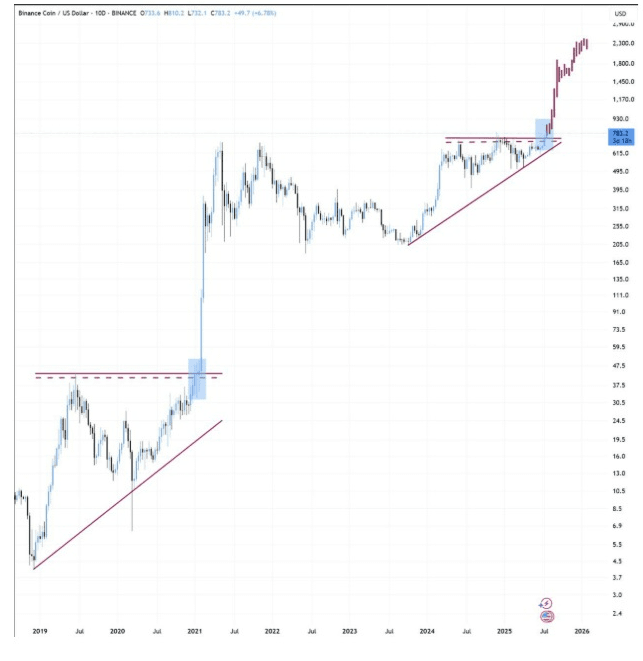
So if you are a fan of BNB, this period might be worth paying attention to, as the bull market is about to erupt—don’t miss the chance to reach the peak!
Friendly reminder: Price targets are often scenario forecasts 'assuming a series of conditions are met'—including macro liquidity, regulatory voices, on-chain security incidents (like CrediX), etc., all of which can change the trajectory. Don’t treat target prices as ironclad rules.
6) Connecting these fragments: What is driving the current market rhythm?
The current market dynamics can be condensed into a few main lines:
Capital rotation: When BTC pulls back or oscillates, short-term capital often flows into higher volatility assets (ETH, BNB, altcoins, NFTs) in pursuit of excess returns;
The practicality of chains and applications: High TPS data points like BNB chain, Ethereum ecosystem’s L2, and innovations in the NFT market enhance the 'productivity' of on-chain activities, attracting users and developers.
Brand and mainstream participation: Luxury goods and big brands entering NFTs bring new buyers and narratives to the market, serving as both capital and a marketing effect.
The reminder effect of security incidents: Events like CrediX rapidly raise the risk premium for small and medium projects, prompting capital to concentrate on more trustworthy and liquid protocols.
Community and sentiment: Community discussions, FOMO (fear of missing out) or FUD (fear, uncertainty, doubt) from Twitter/Telegram/Discord can change the flow of capital in a short time, boosting the trading volume of certain memecoins or thematic coins.
In other words, the market is driven by both structural factors (TVL, chain performance, burn mechanisms) and is instantly influenced by sentiment and news events.

7) Here are 5 practical suggestions for you who are reading this article (not flashy)
Don’t put all your eggs in one basket: high TVL and multiple reputations can reduce exposure risks to 'vulnerabilities/rug pulls'.
Do two rounds of due diligence (DYOR): check contracts, wallets, multi-signatures, the frequency of white paper updates, and team transparency; if you encounter a project that promises 'compensation within 24 hours' but then goes dark, immediately blacklist it.
Beware of token listings on non-custodial platforms: if you see a new pool/token suddenly appear in a liquidity pool on a decentralized exchange, make sure to clarify its source and code before participating.
Layered position management: core (long-term beliefs), tactical (mid-term opportunities), speculative (high risk, high reward), with clear distinctions between positions and stop-loss.
Focus on on-chain data rather than just price: active wallet numbers, contract call counts, slippage, and liquidity depth are often better indicators of a project’s health than short-term K-lines.
8) Outlook: Short-term noise, long-term reconstruction (keep a bit of expectation while staying alert)
The current market has effects of 'traditional scripts' (project rotations during bull market cycles, the arrival of altcoin season), but also has new structural changes: the rise in NFT daily active users indicates a shift in user consumption patterns towards 'digital collectibles + social interactions'. Improvements in the technology and ecology of Ethereum and BNB are pushing the costs and experiences of on-chain activities in a favorable direction, while the record high TVL in DeFi indicates that institutions or large funds are still seeking efficiency on-chain.
However, no bull market comes without a cost: more heat also attracts more 'short-sighted products, rough contracts, and people looking to exit quickly'. The CrediX incident serves as a reminder: while there is high freedom on-chain, it also means individuals must bear more responsibility for discernment and risk management.
Conclusion: Don’t just watch the excitement; look at the fundamentals.
These pieces of news together form a short serialized story: there are unsettling security incidents (CrediX), structural growth (DeFi TVL hits new highs), changes in user behavior (NFT daily active users surpass DeFi), and asset rotations (ETH, BNB, altcoins performing in turns). For the community, it’s essential to learn to enjoy the dividends brought by the market while also learning to buckle up for safety—pay more attention to on-chain data, diversify risks, and avoid blindly following trends.
The last light-hearted note: the market is always changing, and opportunities are always in the changes—organize your positions and curiosity well, and don’t let others make 'regrets after disappearing' for you.😉
Many understand the trends, but few keep pace with the rhythm.
The crypto world changes rapidly, with opportunities and risks coexisting. Learning to enter and exit strategically and protecting the principal is key to steady progress, wealth, and growth.✍️
Remember to DYOR, manage risks well, and wish everyone smooth sailing in the crypto world!🌊
Like and share 👍, follow me to catch more market trends and enjoy the ups and downs of the bull and bear markets together! Let’s keep going!


